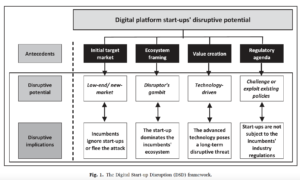The emergence of digital platform start-ups poses a threat to disrupting the logistics industry with new business models. Most of the start-ups rely on business models that involve leveraging digital platforms, making use of the increasingly more digitized communication and distribution systems to connect global communities, and providing access and shared knowledge, products, and services that were previously unavailable.
Digital freight forwarders offer platforms that challenge the service offerings of the traditional incumbent logistics providers. Yet, it is not clear whether these digital platforms have the potential to truly ‘disrupt’ the current industry.
In a new paper, researchers debate a more comprehensive view of the notion of disruption and disruptive innovation in the context of logistics start-ups leveraging digital platforms. They propose a Digital Start-up Disruption (DSD) framework (based on existing literature) that allows characterizing digital platforms and their disruptive potential using four antecedents: initial target market, ecosystem framing, value creation, and regulatory agenda.
- Initial target market: Digital start-ups are more likely to have disruptive potential when the initial target market consists of low-end or new-market customers because the incumbents tend to ignore the start-ups or are not worried as such to lose their least-profitable customers.
- Ecosystem framing: Digital start-ups are more likely to have disruptive potential when they reveal their disruptive intention in their and their incumbents’ ecosystems and adapt their business model continuously according to the ecosystem needs.
- Value creation: Digital start-ups are more likely to have disruptive potential when the business model creates value through a technology-driven innovation instead of a market-driven innovation.
- Regulatory agenda: Digital start-ups are more likely to have disruptive potential when the business model challenges or exploits gaps in existing regulations that protect the incumbent industry firms.
Applying the framework of the four antecedents to a digital freight forwarder case study reveals important insights into the dynamics of disruptive and sustaining technologies. These findings can help investors and funding organizations identify potential disruptive innovation opportunities.






